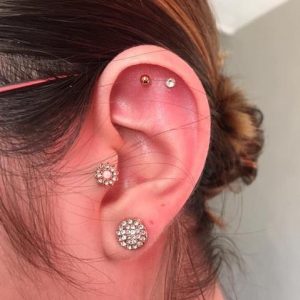A Guide to Ear Piercings – Part III
Ear piercings may be classic, but they certainly continue to have a moment right now. And as the age of the mask may be here to stay for a little while yet, they are a wonderful way of displaying more of your character and style above the nose-line. As long as you take care not to catch and irritate healing piercings with the elastic bands attaching the mask behind your ears.
We have already looked at several iconic and more unusual ear piercings in parts I and II of this guide, but the list goes on. It would be amiss of us not to tell you about the following placements, providing for beautiful options to make your ears into your very own unique pieces of art. They are too good prime  real estate for bejewelling to pass up after all.
real estate for bejewelling to pass up after all.
The flat piercing
While most ear piercings, apart from the insdutrial, derive their names from the official anatomical name of the location on the ear where they are placed, the flat piercings is called so because it sits where the ear is just, well – flat. It sits under the rim of the ear, on the large space of flat cartilage in the upper ear.
Some people opt for a single one and perhaps get a larger piece of jewellery to go with their cartilage stud. Others fill there ‘flat ear’ surface with several simpler piercings for a unique (but sometimes a little crowded) look. If you intend to get several done, its best to discuss this with your artist so that the placement of the first will allow for more space.
The rook
 Still in the top part of the ear but below a flat piercing is where a rook would be. It goes through the inner edge of the uppermost rim of the ear – one step above the daith, and two above the tragus. The rook is a fold of cartilage, which means there will be quite a bit of pressure, and potentially pain, during the procedure itself and for about half an hour after.
Still in the top part of the ear but below a flat piercing is where a rook would be. It goes through the inner edge of the uppermost rim of the ear – one step above the daith, and two above the tragus. The rook is a fold of cartilage, which means there will be quite a bit of pressure, and potentially pain, during the procedure itself and for about half an hour after.
It requires some commitment as it can take anywhere between six to as much as 18 months to heal. However, you will be rewarded with having turned this usually quite unnoticeable corner of your ear into a real attention-grabber. As with any cartilage piercing, proper aftercare is key. Getting the piercing itself is the easy part – the real work comes later.
With all of these options, it may be difficult to make a choice. You may even want to get all of them! However, professionals generally say its best to settle for a couple at a time, and let them heal fully before you go for the next round, not to put your ears through too much trauma at once. Your body expends a lot of energy healing a wound, you want to give it the best foundation possible.
Check in with the next instalment in our piercing series for a guide to proper aftercare!
